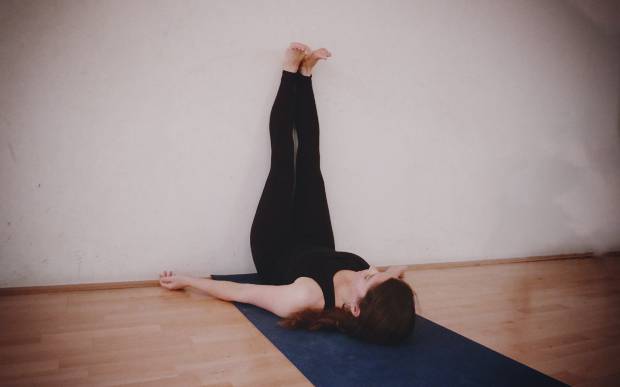Restorative yoga is one of the types of yoga recommended for those who want to focus more on reaping the therapeutic, stress-relieving benefits of yoga. The most important thing when doing restorative yoga poses is to make sure that the students are relaxed and moving at their own pace.
Looking at the examples of Restorative yoga poses below, you will notice that all involve using props or accessories. This reflects the focus of this type of yoga, which is to make sure the students are comfortable, relaxed, and not straining to do any of the poses. Read on to know how these yoga accessories are used in various yoga poses.
Legs Up the Wall Pose (Viparita Karani)
You can pretty much figure out what the end position will be based on the name of the pose, but there are variations to doing it. In Restorative yoga, however, the Viparita Karani is practiced with the help of a yoga blanket or bolster to elevate the lower back and the hips while your back lies flat on the mat. Using a bolster or thick, folded blankets makes the pose easier and more comfortable to do and avoid any discomfort on the hip or sit bones.
Supported Bridge Pose (Setu Bandha Sarvangasana)
The typical Bridge Pose involves lying on your back with your knees bent, and you lift your back and buttocks on the floor. This means your weight falls only onto your shoulders and feet, and you work the thigh and shoulder muscles to keep your body off the ground. With the supported version, you place a yoga block (of sufficient height and sturdiness) on the area between the buttocks and the small of your back to lessen the pressure on the shoulders and thigh muscles.
Supported Child's Pose (Balasana)
The difference between the supported version and the typical Child's Pose is that there is less pressure on the back and abdomen when you bend your body lower onto the floor. You sit with your legs folded underneath you, buttocks resting on the soles of your feet, knees hip-width apart, and you simply bend your upper body lower to rest on the round bolster placed between the thighs. This way, you don't have to bend so low and you simply rest your head on the bolster and let your arms fall to the sides.
Supported Forward Fold (Uttanasana)
This pose is much like the Child's Pose, except this time, your legs are outstretched in front and not folded underneath you. Similarly, the supported version also lessens the stretch and pressure on the back and hamstrings by not having to bend over so low to find a comfortable resting position for the head. Place a bolster vertically on your lap and put a folded blanket on top of it, where your head can rest as you sit on the mat and bend your body forward.
Supported Backbend
This Restorative yoga pose basically involves lying on the mat with a folded yoga blanket or bolster place at the middle of your back to elevate it and create an arch. You can either bend your knees as you lie like this, or stretch your legs out in front of you. You are also free to let your arms rest on the floor either at your sides or above the head.


